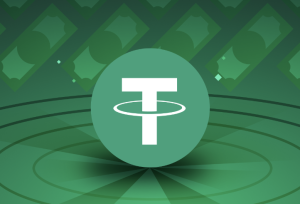
A digital token backed by fiat currency provides individuals and organizations with a robust and decentralized method of exchanging value while using a familiar accounting unit. The innovation of blockchains is an auditable and cryptographically secured global ledger. Asset backed token issuers and other market participants can take advantage of blockchain technology, along with embedded consensus systems, to transact in familiar, less volatile currencies and assets.
In order to maintain accountability and to ensure stability in exchange price, we propose a method to maintain a one-to-one reserve ratio between a cryptocurrency token, called tethers, and its associated real world asset, fiat currency. This method uses the Bitcoin blockchain, Proof of Reserves, and other audit methods to prove that issued tokens are fully backed and reserved at all times.
Tether WhitePaperUnderstanding Tether: A Digital Token Backed by Fiat Currency
Tether (USDT) is a pioneering digital token that bridges the gap between the traditional financial system and the burgeoning world of cryptocurrency. It offers individuals and organizations a robust and decentralized method of exchanging value while maintaining the stability and familiarity of a fiat currency. Tether is one of the most prominent examples of a stablecoin—a cryptocurrency that is designed to maintain a stable value by being pegged to a reserve of assets, typically fiat currencies like the US dollar, Euro, or other major currencies.
The Innovation of Tether and Blockchain Technology
At the core of Tether’s innovation is its use of blockchain technology, which provides an auditable and cryptographically secured global ledger. This ensures that every transaction involving Tether tokens is recorded on the blockchain, offering transparency and security that is unmatched by traditional financial systems. Blockchain’s decentralized nature means that no single entity controls the ledger, making it resistant to tampering or fraud.
Tether utilizes this technology to offer a digital token that is backed by fiat currency. This allows users to enjoy the benefits of cryptocurrencies—such as fast transactions, lower fees, and global accessibility—while mitigating the volatility that is often associated with digital assets like Bitcoin and Ethereum. By being pegged to a stable asset like the US dollar, Tether provides a stable accounting unit that is crucial for many users and businesses who want to engage with the crypto ecosystem without being exposed to high levels of risk.
How Tether Maintains Stability: The One-to-One Reserve Ratio
One of the key features that set Tether apart from other cryptocurrencies is its one-to-one reserve ratio. This means that for every Tether token (USDT) in circulation, there is an equivalent amount of fiat currency held in reserve by Tether Limited, the company behind Tether. This reserve ensures that Tether tokens are always fully backed by real-world assets, maintaining the token’s value and stability.
To maintain accountability and ensure that the price of Tether remains stable, Tether Limited employs several methods. One of the most important is the concept of Proof of Reserves. This method uses the transparency of the blockchain to demonstrate that the issued Tether tokens are fully backed by the corresponding fiat reserves. The company regularly publishes attestations by independent auditors, who verify that the reserves match the number of Tether tokens in circulation. This level of transparency is critical in maintaining trust among users and ensuring that the token’s value remains stable.
The Role of Bitcoin Blockchain and Other Audit Methods
Tether was initially launched on the Bitcoin blockchain using the Omni Layer protocol, which is a platform for creating and trading custom digital assets on top of the Bitcoin blockchain. The use of the Bitcoin blockchain, one of the most secure and widely used blockchains, provides a solid foundation for Tether’s operations. The Bitcoin blockchain’s robustness ensures that transactions involving Tether are secure and that the underlying ledger is immutable and resistant to fraud.
In addition to using the Bitcoin blockchain, Tether has since expanded to other blockchains, including Ethereum (as an ERC-20 token), Tron, and others. This multi-chain approach increases Tether’s accessibility and flexibility, allowing users to transact Tether tokens on their preferred blockchain platform.
To further enhance trust and transparency, Tether employs various audit methods. These audits are conducted by reputable third-party firms that verify the company’s reserves and ensure that the tokens in circulation are fully backed. These audits are a key component of Tether’s commitment to maintaining a stable value and providing assurance to users that their tokens are backed by real-world assets.
The Importance of Tether in the Cryptocurrency Ecosystem
Tether plays a critical role in the broader cryptocurrency ecosystem. As a stablecoin, it provides a safe harbor for investors and traders during times of market volatility. When the prices of other cryptocurrencies like Bitcoin and Ethereum fluctuate wildly, users can convert their holdings into Tether to preserve value without needing to exit the crypto market entirely. This functionality makes Tether an essential tool for traders who need stability to manage their portfolios effectively.
Moreover, Tether facilitates easier and faster transactions between different cryptocurrency exchanges. Since Tether is pegged to the US dollar, it simplifies the process of transferring value between exchanges without the need for traditional banking systems, which can be slow and expensive. This efficiency has led to Tether being one of the most traded cryptocurrencies by volume, often acting as a bridge currency in the crypto trading world.
Criticisms and Controversies Surrounding Tether
Despite its widespread use and importance, Tether has faced its share of criticisms and controversies. The most significant concern revolves around whether Tether is truly backed by an equivalent amount of fiat currency. Over the years, there have been debates and legal challenges questioning Tether’s transparency and the adequacy of its reserves.
In response to these concerns, Tether Limited has taken steps to increase transparency, such as publishing periodic attestations of its reserves and improving its auditing processes. However, some skeptics remain unconvinced, arguing that Tether’s centralization and the lack of regular, comprehensive audits still leave room for doubt.
Another criticism of Tether is its potential to influence the cryptocurrency market. Given Tether’s large market capitalization and its role as a major trading pair on exchanges, there are concerns that large movements of Tether could impact the prices of other cryptocurrencies. This has led to ongoing scrutiny from regulators and market analysts who are concerned about the systemic risks Tether might pose to the broader financial system.
The Future of Tether and Stablecoins
Looking ahead, Tether and other stablecoins are expected to continue playing a significant role in the cryptocurrency and digital finance space. As more assets become tokenized, the demand for stablecoins like Tether is likely to grow, providing a critical link between traditional finance and the digital asset ecosystem.
Furthermore, as the regulatory landscape evolves, Tether may face increased scrutiny and oversight. This could lead to more rigorous auditing and transparency requirements, which, while challenging, could ultimately strengthen Tether’s position in the market by increasing user trust.
In conclusion, Tether has established itself as a key player in the world of cryptocurrencies by offering a stable, reliable, and accessible digital token backed by fiat currency. While it has faced challenges and criticisms, its role in facilitating transactions, providing stability, and bridging the gap between traditional and digital finance cannot be understated. As the cryptocurrency market continues to mature, Tether is likely to remain a central component of the ecosystem, driving innovation and helping to shape the future of digital finance.
